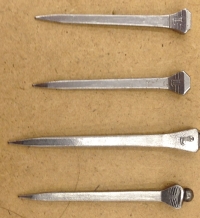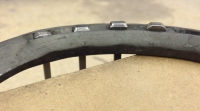The fit and finish of a nail is something most farriers are very familiar with. Many other horsemen may not realize the ins and outs of choosing the correct nail for a given shoe package.
Step one is selecting the correct nail, which we will cover here. Next time, nail patterns will be discussed, as in how many and where they should, or more importantly, should not go.
Certainly your farrier will usually decide what nail to use, but I think it important for horsemen to understand the reasoning behind this very critical part of a horseshoeing.
First of all, one cannot just say, "I want to use a size-4 nail." The nail head alone may offer 3-4 different choices within that size. Fig. 1 shows four styles. Top to bottom are: a race nail, city head, E head, and a regular head with borium.
A race nail is made to fit more American-style shoes. These are full-swedge, half-swedge, half-rounds and many aluminum shoes. As the name implies, it is applicable in most race horse situations. City head is similar to a race nail, but slightly more proud at the top. E head is used in many European-style shoes, many of which are fullered (grooved or creased) through the nail holes. The borium headed nail is, of course, a traction device.
 (Photos by the author) Fig 1: A race nail, city head, E head and a regular head with borium.
(Photos by the author) Fig 1: A race nail, city head, E head and a regular head with borium.
After getting past the head shape, you may then choose length and/or profile of the shank. They can be XL (extra long) or SB (slim blade). Extra long needs no explanation. Slim blade is a thinner profile nail that is more forgiving on thin, shelly, or overused hoof walls.
Size is another factor. 3.5 to 6 are most common in Standardbreds, though one would almost never use a size 6 on a race horse. 3.5 and 4.5 are the only half sizes. The size and head shape are extremely important to maintaining a good hoof.
Too small and the nail isn't tight enough in the shoe to prevent movement. Too large and you stress the hoof wall by the sheer size of the nail shank. If the head is too big, you change the traction effects of that shoe (with a borium nail, one might want to do this intentionally).
Fig. 2 shows four different nails in the same fullered shoed. From left to right: 1 is too small. It is actually twisted within the nail hole. When a nail is moving around in its nail hole this causes hoof wall trauma. The second and third nails from the left are size 3 and 4 E head, and the fourth is a size 4 race nail. Second from the left is a perfect fit. It completely fills the fullering without allowing any room for twisting. Nail 3 is the same shape but just slightly over-sized. The fourth nail from the left is very slightly narrow and tall for that fuller, but the fit would do in a pinch.


Incidentally, when deciding whether or reset a shoe or not, the condition of nail holes is often the determining factor. If those nail holes are beginning to look more rounded than square, it is time for a new shoe. Sometimes I will go up a half-size nail on a reset to get the same fit as I did before.
As with shoe size, when torn between which sizes to use, I recommend the larger of the two choices in every case. The nail I use the most is a 4.5 XL SB, or size 4.5 extra long, slim blade. Extra long allows me to drive nails higher up the hoof wall past the old tracks of previous nails. By the way, the hoof wall does not get significantly thinner until it is near the coronet band. This is well past the height of any ordinary nail patterns.
Having the correct nail in a given shoe is a big step in the process of effective horseshoeing. It will keep the shoe on longer while maintaining a better hoof wall. Getting the right nail for a horseshoe isn't as hard as finding the perfect fit for a glass slipper, but, as the story goes, could offer princely rewards.
Veteran Standardbred farrier Steve Stanley of Lexington, Ky., authors a monthly column for Hoof Beats, the official harness racing publication of the U.S. Trotting Association. The American Farriers Journal Editorial Advisory Board member offers plenty of practical advice that will be of special interest regardless of the type of horses that you work with. Click here to read more from Steve Stanley's Hoof Beats series.








Post a comment
Report Abusive Comment